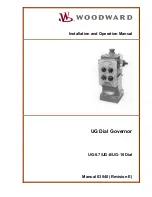
Manual 03040
UG Dial Governor
Woodward
9
Operating a governor continuously beyond the high limit temperature of the oil
will result in oil oxidation. This is identified by varnish or sludge deposits on the
governor parts. To reduce oil oxidation, lower the actuator operating temperature
with a heat exchanger or other means, or change to an oil more oxidation-
resistant at the operating temperature.
A loss of stable governor control and possible prime mover
overspeed may result if the viscosity exceeds the 50 to 3000 SUS
range. An overspeeding and/or runaway prime mover can result in
extensive damage to the equipment, personal injury and/or loss of
life.
Specific oil viscosity recommendations are given on the oil chart (Table 2-1).
Select a readily available good brand of oil, either mineral or synthetic, and
continue using that same brand. Do NOT mix the different classes of oils. Oil that
meets the API (American Petroleum Institute) engine service classification in
either the “S” group or the “C” group, starting with “SA” or “CA” through “SF” and
“CD” is suitable for governor service. Oils meeting performance requirements of
the following specifications are also suitable: MIL-L-2104A, MIL-L-2104B, MIL-L-
2104C, MIL-L-46152, MIL-L-46152A, MIL-L-46152B, MIL-L-45199B.
Replace the governor oil if it is contaminated, also change it if it is suspected of
contributing to the governor instability. Drain the oil while it is still hot and
agitated; flush the governor with a clean solvent having some lubricating quality
(such as fuel oil or kerosene) before refilling with new oil. If drain time is
insufficient for the solvent to completely drain or evaporate, flush the governor
with the same oil it is being refilled with to avoid dilution and possible
contamination of the new oil. To avoid recontamination, the replacement oil
should be free of dirt, water, and other foreign material. Use clean containers to
store and transfer oil.
Observe the manufacturer’s instructions or restrictions regarding the
use of solvents. If no instructions are available, handle with care. Use
the cleaning solvent In a well ventilated area away from fires or
sparks.
Failure to follow the safety instructions above can result in
dangerous fires, extensive damage to equipment, personal injury
and/or loss of life.
Oil that has been carefully selected to match the operating conditions and is
compatible with governor components should give long service between oil
changes. For governors operating under ideal conditions (minimum exposure to
dust and water and within the temperature limits of the oil), oil changes can be
extended. If available, a regularly scheduled oil analysis is helpful in determining
the frequency of oil changes.
Any persistent or recurring oil problems should be referred to a qualified oil
specialist for solution.
The recommended continuous operating temperature of the oil is 60 to 93 °C
(140 to 200 °F). The ambient temperature limits are –29 to +93 °C (–20 to +200
°F). Measure the temperature of the governor on the outside lower part of the
case. The actual oil temperature will be slightly warmer, approximately 6 °C
(10 °F).
Summary of Contents for UG-10 Dial
Page 5: ...Manual 03040 UG Dial Governor Woodward iii...
Page 6: ...UG Dial Governor Manual 03040 iv Woodward Figure 1 1 UG 8 Dial Governor...
Page 9: ...Manual 03040 UG Dial Governor Woodward 3 Figure 1 3 UG Dial Governor Outline Drawing...
Page 14: ...UG Dial Governor Manual 03040 8 Woodward Table 2 1 Oil Chart Table 2 2 Viscosity Comparisons...
Page 18: ...UG Dial Governor Manual 03040 12 Woodward Figure 3 1 UG Dial Governor Schematic Diagram...






























